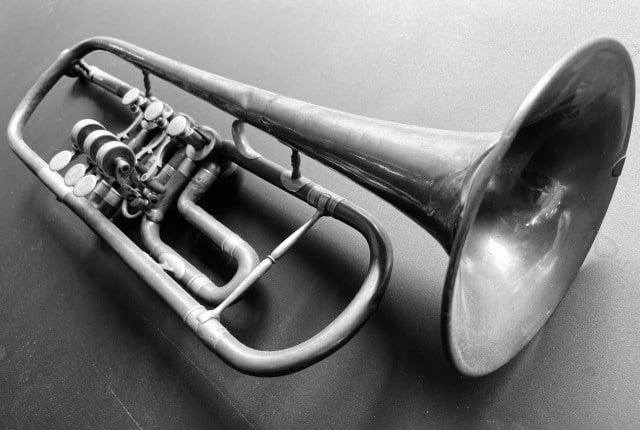So you got a brand new trumpet, did some playing and now it feels not as smooth anymore? You experience hang ups, the keys feel creaky, the sound is not exactly the same and something feels off? Trumpet maintenance is in order!
Time to visit the trumpet doctor and get some trumpet healthcare ASAP. Luckily, regular check-ups will suffice – with you being the trumpet doctor. Yes, that’s right – no need to visit the music store for expensive maintenance, and no need to wait days or weeks just to keep your trumpet shining and in good order. You can keep your trumpet nice and healthy in several easy steps. Today, we’ll show you how to take care of your trumpet on your own with our top 3 trumpet maintenance tips!
1. Oiling the Valves
This is the most complicated procedure, so we’ll cover it first. It may seem daunting at the beginning, but it’s actually simple, so read on!
If you got yourself a brand new trumpet, you will need to get some valve oil* and oil the valves of your instrument every day. The same applies for oil change – you should change the oil on a new trumpet at least once a week. Keeping the valves well lubricated during the first month helps your trumpet get ‘accustomed’ to all its parts – the smoother they move, the happier the trumpet, and the better your sound. For used trumpets (after a month or so), be sure to oil the valves every couple of days (2-3 times a week), and change the oil every couple of months.
All right, you ask, but why? Well, valve oil has three main purposes: it enables smooth operation of the valves and keys, it keeps dirt and debris out (the smoothness of the oil flushes out any debris to the sides), and it keeps your trumpet parts airtight, so no air escapes. All of this makes your trumpet sound good when you toot toot!
Before you begin
The best way to actually oil the valves is if you have the trumpet tilted approximately 45 degrees downwards, like when playing. This helps the oil drops spread easier on the valve surface.
For easy convenience, you can number the valves with numbers. For example, valve number 1 can be the one closest to your mouth, and valve number 3 can be furthest from your mouth and closest to the bell of the trumpet. Valve number 2 is, of course, the one in the middle.
Once you’ve organized yourself thusly, focus on one valve at a time. It is best to start from valve 3, because it makes diagnosing any air-flow problems easier. For example, after oiling a valve, you should try and blow gently through the trumpet.
If the air flows, you’re good. But if it doesn’t, you need to take out the valve again, clean it up, and repeat the process. Starting from the valve further out makes it unnecessary to remove all the other valves just to test the air-flow.
Looking for a teacher?
Want to get lessons at the comfort of your own home? Check out the course Learn to Play the Trumpet: Beginner to Pro Made the Easy Way* on Udemy! (See their full trumpet course line-up here*!)
How to do it
First, unscrew the valve cap (the ring piece that connects the trumpet key to the trumpet – not the key button itself). This should make the valve come out loose, so you can see the internal parts: the spring, the valve guide and the valve itself (the lowermost part with the holes).
Take care not to pull out the valve entirely, and very important: try not to rotate it. If you do, you might have to keep twisting it until it clicks back into place.
Then, apply 2 to 4 drops of oil around the valve. Too many drops will make the trumpet keys slow and sticky, but too few will make it creaky. Depending on your specific valve condition, apply the required number of oil drops.
Repeat with the other two valves. If the valves (trumpet keys) move smoothly and quickly, congratulations, you’ve done a good job!

Notes
Keep in mind that besides oiling your valves, you will also need to change the oil entirely. This means taking out the valves, cleaning them with a lint-free cloth, applying oil and putting them back in. Basically, just like oiling the valves but with thorough cleaning before you apply the oil. Changing the oil prevents gunk buildup from stuffing your keys. Finally, here’s some quality valve oils you can use: Blue Juice Valve Oil, Rocket Professional Valve Oil, Hetman Synthetic Classic Piston Lubricant, Al Cass Fast Valve Oil and Holton Valve Oil just to name a few.
2. Grease the Slides
A fairly simpler procedure than the previous one, but just as important. What you will need is some slide grease (Yamaha* or Hetman* have good products which are excellent for the job).
Next, take out every slide (there are a total of four slides on a trumpet), apply some slide grease on the outer side of the tube, and smear it over it as equally as possible. Yes, you will probably have to use your fingers and get yourself all greasy. But hey, it’s a small sacrifice.
Finally, after greasing a slide, put it back in place, and try moving it – if it moves smoothly, but still not too loosely, you’ve done great. Slides shouldn’t move too easily nor feel too sticky. Repeat with the other slides.
You should grease your trumpet’s slides at least once a month to ensure smooth trumpet operation and smooth sounds.

Image: Source
3. Clean the Mouthpiece
Keeping your mouthpiece clean is by far the simplest maintenance procedure. Just swab the diameter with a special mouthpiece brush* whenever you remember to do it.
Alternatively, you can wash your mouthpiece by running it under hot water and dish soap. Of course, you should then wipe it clean and leave to dry.
Conclusion
Those were our top 3 trumpet maintenance tips. We hope you found them useful, and that you’ll be following them religiously – for your trumpet’s sake. And, last but not least – please remember to put some towels or an old t-shirt under your trumpet when playing with all the grease and oil! Mom’s carpet needs to be kept in good condition, too.
Related Posts:
- Complete Guide to Trumpet Stands
- The Best Trumpet Cases (An Illustrated Guide)
- Trumpet Parts (An Illustrated Guide)
- The 5 Worst Things When it Comes to Playing a Trumpet (and How to Avoid Them!)
- How To Practice The Trumpet Quietly
TrumpetHub.com is a participant of the Amazon Services LLC Associates Program, an affiliate advertising program. Links marked with an asterisk (*) are affiliate links. If you buy a product through an affiliate link, we will get a small commission without extra cost to you. This helps us earn an income off the free content we provide to you. Thank you for your support!




